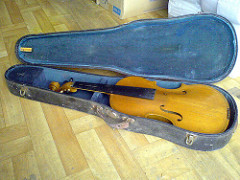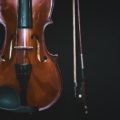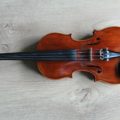Even if you’re left-handed, you can still learn to play the violin Play the Violin - A Whole Novice's Guide - The violin, also known as a fiddle, is a bowed string instrument. It has four strings that are tuned in perfect fifths. The violin is the smallest and highest pitched member of the string instrument family, which also includes violas and cellos. Although playing the violin can be quite challenging, when mastered, it produces a… as if you were right-handed. In fact, some left-handed individuals claim to have an advantage, as their dexterity in the left hand makes fingering and vibrato easier and more precise. By the time you become a master violinist, you’ll become ambidextrous. During peak performances, both hands will move almost automatically, driven by memory and habit.
Each part of the bow has its own name, and technically, “the bow” refers only to the wooden stick to which the hairs are attached. The “grip” wraps around one end of that stick, and “the frog” connects the bow with the hairs. Your bow has a large screw at its tip, and you use the screw to tighten or loosen the hair. Before each day’s practice, check the tightness of your bow. At the narrowest point of the bow, the space between the hairs and the bow should be no larger than your middle finger.
After checking the tightness of the hair, visually inspect your bow to ensure it remains properly aligned. If you tighten your bow too much, you may bend or warp it, significantly altering the quality of the sound.
Instinct and intuition will guide you to pick up and hold the bow almost correctly. However, for the sake of propriety, you should curl your thumb around the frog, supporting the weight of the bow. Then wrap your index, middle, and ring fingers around the grip, and rest your pinky lightly on the screw. Your pinky acts as your first pressure regulator. By resting it almost imperceptibly on the screw, you allow the full weight of the bow to fall on the strings, resulting in louder sounds. By lightly pressing your pinky against the screw, your thumb becomes the fulcrum of the bow, and you gently draw the bow away from the strings, reducing the volume. For maximum sound, use your wrist and forearm to increase the pressure of the bow against the strings and move the bow to the position where the bridge holds the strings furthest from the body of the violin Violin Exercises For a Masterful Performance - Playing the violin undoubtedly requires exceptional skill, a keen ear for music, and remarkable concentration to enable the violinist to produce the exquisite melodies characteristic of a flawlessly executed violin piece. The sound produced by a violin is distinct, setting it apart from all other instruments in an orchestra, and entirely different from its fellow… .
As you draw the bow back and forth across the strings, your right hand, wrist, and forearm control the tone and rhythm. On the day you brought your violin Your Violin Bow - It's Just Elementary Physics - As your violin skills and passion develop, it's essential that your violin bow evolves with them. Your first bow was likely chosen for durability and protection against accidents, perhaps even an all-synthetic bow for your initial learning and introduction to the violin's intricacies. As you progress, it's wise to keep that initial bow as a… home, you likely played and experimented with the various sound effects, exploring the limitless range of pitches, timbres, and harmonies that can be created by adjusting the pressure on the bow, changing its position on the strings, and altering the length and speed of the strokes. Your lessons will teach you when, where, and how deliberately to produce different effects based on words, signs, and symbols in the printed score.
In violin terminology, “articulation” refers to how you strike the strings with your bow and how you control the notes by lengthening or shortening your strokes and either leaving the bow resting on the strings between notes or lifting it off. Violin vocabulary includes a term for forcefully striking the bow against the strings, a separate term for applying full weight and pressure to the strings, and a range of terms that instruct you on how to move the bow across the strings. Other violin vocabulary terms indicate using the widest part of the bow near the frog, the narrowest part near the tip, or the middle of the bow. Additionally, there are terms that guide your transitions from note to note and measure to measure. Naturally, since the violin originated in Renaissance Italy and Southern France, much of the violin vocabulary is derived from Italian or French. Some purists in the violin world may consider suggesting easy English translations or universal symbols for all these commands to be seen as wrong.
Manuel Marino is a seasoned Senior Producer, Music Composer, and Artist with over a decade of experience. He specializes in branded entertainment across various mediums, including video games, films, and advertising campaigns. With 20+ years as a game music composer, Manuel has worked on numerous platforms, creating diverse orchestral soundtracks. HIRE ME


 Manuel is a passionate, driven, and techsavvy AV technician,
Manuel is a passionate, driven, and techsavvy AV technician, 



